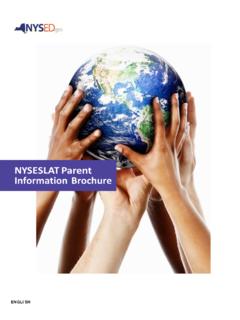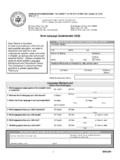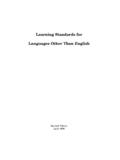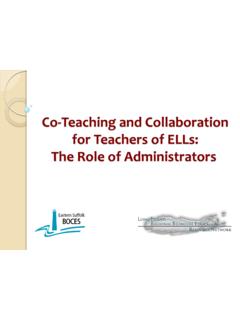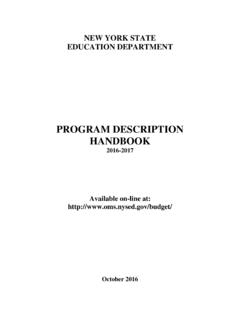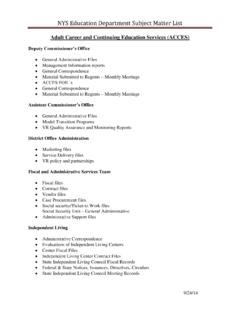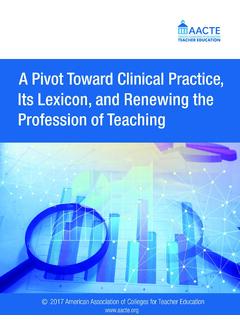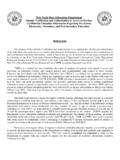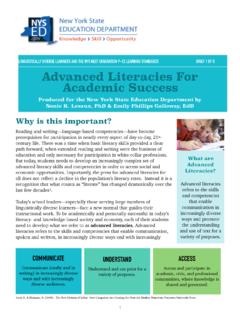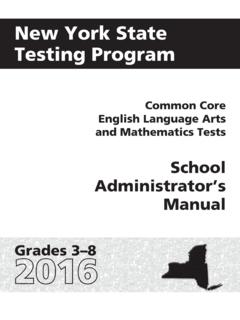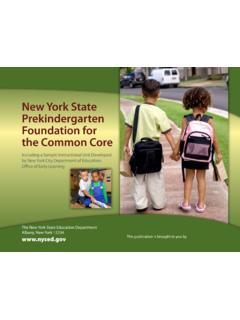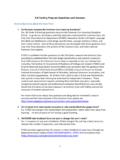Transcription of A GUIDE FOR PARENTS OF ENGLISH LANGUAGE …
1 New york State education department Office of Bilingual education and World L anguages A GUIDE FOR P ARENTS OF ENGLISH LANGUAGE learners IN NEW york STATE Dear Parent/Guardian, The Office of Bilingual education and World Languages at the New york State education department strives to provide students whose home languages are other than ENGLISH access to equity and excellence in education . If your child s home LANGUAGE is other than ENGLISH and he or she is learning, or on the way to learning ENGLISH , your child is becoming bilingual. Congratulations! Bilingual children have unique assets and advantages and have great opportunities ahead. The New york State education department strongly values bilingualism and strives to provide the best setting for your child to develop his or her full LANGUAGE potential. We invite you to learn about the educational programs available for newly enrolled students with home or primary languages other than ENGLISH who need support in reaching ENGLISH LANGUAGE proficiency.
2 These students are called ENGLISH LANGUAGE learners (ELLs) or Multilingual learners (MLLs). We recognize that these students are not only developing ENGLISH skills but becoming biliterate or, in some cases, multilingual children. With more than 200 languages spoken within its borders, New york State is one of the most culturally and linguistically diverse places in the world. Having more than one LANGUAGE is among our students greatest assets. Thus, educational programs f or ELLs across New york State aim to draw on the home or primary LANGUAGE as a resource to ensure that all students are able to excel academically. In this GUIDE , you will find information about how children are identified as ELLs, the kinds of programs available for ELLs, when students can exit ELL programs and services, and how you can obtain additional information, materials, and r esources from local schools.
3 We believe PARENTS and families play a fundamental r ole in determining which program best addresses the social, cultural, and academic needs of their children. We are excited to partner with you and look f orward to working with you throughout this process. Best wishes for a happy, healthy, and successful academic y ear! Sincerely, Angelica Infante-Green Associate Commissioner of Bilingual E ducation and World Languages The Office of Bilingual E ducation and World Languages New Y ork State education department Frequently Asked Questions about ENGLISH LANGUAGE learners (ELLs) Page 1 Programs in F ocus Page 2 Bilingual education Transitional Bilingual education ProgramsPage 2 One or Two-Way Dual LANGUAGE ProgramsPage 2 ENGLISH as a New LANGUAGE Programs Page 3 Myths about ENGLISH LANGUAGE learners and Multilingual learners Page 5 Did You Know?
4 F acts about Bilingualism and Bilingual education Page 7 Participating in Your Child s education Page 9 Resources for PARENTS of ELLs Page 10 TABLE OF CONTENTS How is my child identified as an ENGLISH LANGUAGE L earner (ELL)/Multilingual Learner (MLL)? In New york State, all newly enrolled students and students re-enrolling after two years are required to complete a Home LANGUAGE Questionnaire (HLQ). The HLQ must be conducted at the time of enrollment. Through this survey, along with an informal interview, a qualified teacher or other professional staff member will get to know what languages are used in the home. If the survey and the interview indicate that a LANGUAGE other than ENGLISH is used in the home, your child must take an ENGLISH LANGUAGE proficiency test called the New york State Identification Test for ENGLISH LANGUAGE learners (NYSITELL). The NYSITELL results are then used to assess your child s ENGLISH LANGUAGE level (Entering, Emerging, Transitioning, Expanding, and Commanding).
5 If your child scores at Entering (Beginning), Emerging (Low Intermediate), Transitioning (Intermediate), or Expanding (Advanced), he or she is identified as an ELL. ELLs are entitled to receive Bilingual education (BE) or ENGLISH as a New LANGUAGE (ENL) services. If a student scores at the Commanding (Proficient) level he or she is not identified as an ELL. The NYSITELL results help teachers better prepare and serve their students. Teachers use this information to identify a student s ENGLISH LANGUAGE strengths and needs in listening, speaking, reading, and writing. These results also GUIDE the school in programming the minimum number of minutes of ENGLISH as a New LANGUAGE (ENL) instruction per week for the student. The process of identification must be conducted prior to the beginning of the school year or no later than within the first ten days of a student s enrollment.
6 Le vel Description of ENGLISH LANGUAGE Proficiency Level Entering (Beginning) A student at the Entering level has great dependence on supports and structures to advance academic LANGUAGE skills and has not yet met the linguistic demands necessary to demonstrate ENGLISH LANGUAGE proficiency in a variety of academic contexts (settings). Emerging (Low Intermediate) A student at the Emerging level has some dependence on supports and structures to advance academic LANGUAGE skills and has not yet met the linguistic demands necessary to demonstrate ENGLISH LANGUAGE proficiency in a variety of academic contexts (settings). Tr ansitioning (Intermediate) A student at the Transitioning level shows some independence in advancing academic LANGUAGE skills, but has yet to meet the linguistic demands necessary to demonstrate ENGLISH LANGUAGE proficiency in a variety of academic contexts (settings).
7 Expanding (Advanced) A student at the Expanding level shows great independence in advancing academic LANGUAGE skills and is approaching the linguistic demands necessary to demonstrate ENGLISH LANGUAGE proficiency in a variety of academic contexts (settings). Commanding (Proficient) A student at the Commanding level has met the linguistic demands necessary to demonstrate ENGLISH LANGUAGE proficiency in a variety of academic contexts (settings). He or she is not an ELL. FREQUENTLY ASKED QUESTIONS ABOUT ENGLISH LANGUAGE learners (ELLs)/MULTILINGUAL learners (MLLs) Programs in Focus What are the programs available for ENGLISH LANGUAGE learners ? Currently, New york State offers two approved program models for ELLs in state school districts: 1. Bilingual education The Transitional Bilingual education (TBE) Program The One or Two-Way Dual LANGUAGE Program (OWDL/TWDL) 2.
8 ENGLISH as a New LANGUAGE (ENL) Program (formerly known as ENGLISH as a Second LANGUAGE or ESL) Both program models support the academic achievement of ELLs, but the instructional time spent in the home or primary LANGUAGE and in ENGLISH differs in each model. Families may choose to have their children participate in a Transitional Bilingual education , a One or Two-Way Dual LANGUAGE , or an ENGLISH as a New LANGUAGE program. If these programs are not available at the local school, you may request a transfer to a school that offers your program of choice. ELLs in Transitional Bilingual education or One or Two-Way Dual LANGUAGE programs are mandated to receive the same amount of specific units of ENL instruction as students in the ENL model. At a minimum, ELLs are mandated to receive ENL instruction. For more information, go to: Bilingual education Transitional Bilingual education Transitional Bilingual education Programs offer students of the same home/primary LANGUAGE the opportunity to learn to speak, understand, read, and write in ENGLISH while continuing to learn academic content in their home/primary LANGUAGE .
9 The students home/primary LANGUAGE is used to help them progress academically in all content areas while they acquire ENGLISH . The goal of a TBE Program is to provide students with the opportunity to transition to a monolingual ENGLISH classroom setting without additional supports once they reach proficiency. Even though the amount of ENGLISH instruction students receive will increase over time, in a TBE program, there will always be home/primary LANGUAGE instruction and supports, allowing students the opportunity to develop bilingually. One or Two-Way Dual LANGUAGE Programs These programs are designed to help native and nonnative ENGLISH speakers achieve bilingualism (the ability to speak fluently in two languages), biliteracy (the ability to read and write in two languages), cross-cultural competence, and academic proficiency equal to that of students in non-ELL programs.
10 The One-Way Dual LANGUAGE Program is primarily composed of students who come from the same home/primary LANGUAGE and/or background. The teacher provides instruction in both ENGLISH and the home/target* LANGUAGE . The Two-Way Dual LANGUAGE Program includes both native ENGLISH speakers and ELLs. The teacher or teachers provide instruction in both ENGLISH and the home/primary LANGUAGE . In the majority of Dual LANGUAGE Programs, the students receive half of their instruction in their home/primary LANGUAGE and the remainder of their instruction in the target LANGUAGE . Depending upon the model, the percentages of ENGLISH and home/target LANGUAGE instruction will vary. For example, in a 90%-10% model, a greater percentage of the instruction is in the target LANGUAGE other than ENGLISH and increases over time until reaching 50%-50%. The goal of these programs is for students to develop literacy and proficiency in ENGLISH and in the home/target LANGUAGE .

